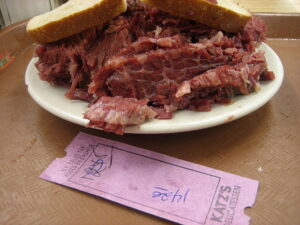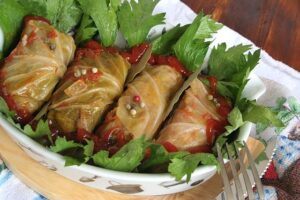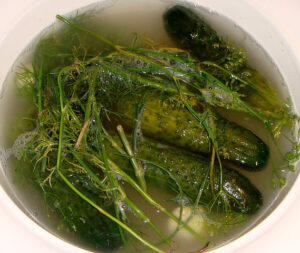Anyone who has read my blog regularly knows that I try very hard to explore Jewish Food beyond the Ashkenazi staples that so many people think of when they think of Jewish Food. However, I also do my best to “defend” Ashkenazi food against the attacks I see as unwarranted. People think of it is boring, un-tasty, and monolithic. In reality, Ashkenazi cuisine is just as diverse as the foods of any other subset of Jewish Food, so I want to take this post to explore, in brief, the vast array of differences between the foods of different Ashkenazi subcultures.
I am writing this post at the start of Yom HaShoah, Holocaust Remembrance Day here in in Israel. There isn’t a tremendous amount of directly related food topics, though I did write a post about it last year. Still, since the Shoah primarily attacked Ashkenazi culture, highlighting this diversity within Ashkenazi food is one small way to fight back against the destruction wrought by the Nazis, and explore how we triumphed in the end. we’re still here, and we’re thriving.
Why Ashkenazi Food Seems Monolithic

Beyond that, however, in America (where about 95% of that massive Jewish population is of Ashkenazic descent) the foods of different subsets of that community blended together and were served side-by-side. This was particularly true in Jewish delis during the 20th century. You could walk in and order foods that stemmed from Russia, Poland, Romania and Germany in a single restaurant — something that never really happened much in Europe.
In reality, however, the foods of those countries’ Jewish communities (and those of many more) were quite distinct from each other. Eastern European, Hungarian and German foods were no less diverse than were the foods of Morocco, Tunisia and Libya, or those of Persia, Iraq and Kurdistan. Let’s look at some of the dishes (I am in no way trying to be comprehensive) and common ingredients of these cuisines to understand that core diversity.
Different Communities, Different Foods
France/Rhineland
Ashkenaz was a medieval term applied to the border territory between France and Germany. The original Ashkenazi community stems from the areas of Alsace and Lorraine in France and the Rhineland in Western Germany. The foods of that region, as an older community, bear a lot of similarities to the foods that non-Jews in that area consumed. Some of the classic dishes include various types of charcuterie, but using beef instead of pork products, due to kashrut. Picklefleisch (use Google translate to read that link), a precursor to American corned beef, is a great example. The choucroute garnie that I wrote about previously — preserved meats cooked with fresh sauerkraut — is another classic example of the food from this region. And as the region was home to quality wine production (something not really possible in colder Eastern Europe), wines such as Riesling, Champagne and Gewürztraminer were also more common for Jews there.
Germany
As Jews moved deeper into the Central European parts of Germany, their food changed as well. Kugel was invented there, and the precursors of such Ashkenazi food classics as gefilte fish and challah also entered the Jewish menu. Dumplings became very popular (and, in fact, that is how kugel began). Sour flavors became even more popular, with examples being sauerbraten and the sweet-and-sour carpe a la juive (getting the French name as it moved back to the Ashkenazi heartland). Cabbage and fruits such as berries also found their way into this more sophisticated cuisine, along with various pickled vegetables.
Eastern Europe
The Jewish population of Poland, Lithuania and western Ukraine ballooned to become the largest Jewish community in the world. This, despite a greater degree of poverty and a less diverse array of ingredients. Still, even within this limited larder, there were quite an array of different fresh produce. Fruits such as plums and apples, nuts, intensely flavored wild mushrooms, and root vegetables such as turnips and carrots were used in multiple ways. Classic dishes of this region include tzimmes, rye bread, and bagels, along with offal dishes such as chopped liver and ptcha. While chicken soup probably came to Eastern Europe from Germany, it became more of a staple dish in Poland, along with other frugal Ashkenazi foods such as gefilte fish and knishes. And the famous yeast cake known as babka originated here, or perhaps in Russia nearby.
Russia
Further to the east, the Jews of Russia consumed Slavic dishes, much as those of Alsace ate French-inspired foods. Kasha varnishkes — buckwheat groats and bowtie noodles — derives largely from non-Jewish foods of the region, as does kishke. Borscht is another classic, a soup made in a uniquely Jewish way to avoid mixing milk and meat products. Buckwheat also is the key ingredient in blini. None of these dishes would be commonly found in Central and Western European Ashkenazi cuisines.
Hungary and Romania

Austria
Due to its location, Austria features a cross between German and Hungarian foods, to a degree. The Jews of Vienna, in particular, were a somewhat wealthier bunch, and so their foods were typically more upscale and stately. The foods of the Austrian Ashkenazim also showed some influence from Italy, to the south, incorporating more tomato, for example. Schnitzel was as popular among Austrian Jews, as it was among other Austrians, since real Wiener Schnitzel is made using veal. Poorer Jews might have used chicken, while non-Jews would have replaced the veal with pork. (Of course, liberal Jews who had abandoned the laws of kashrut may have done the same.) And while the Linzer torte may or may not actually have Jewish origins, it has certainly become famously associated with the community.
20th Century Ashkenazi Food

For starters, it became blander, due to the influence of “modern” kitchen science in the early twentieth century. I plan to write more about this in a different post, but allegedly well-meaning people tried to get immigrants to change the foods they ate, and how they prepared them.
Additionally, new foods that weren’t traditionally Ashkenazi staples, or at least not specific to the Jews of the region, became associated with the community. The pickles we consumed were not unique to the Jews of Eastern Europe, but since we were the ones who ate and sold them the most in America, we now have the term “Kosher Dills” as a reminder. New foods such as the hot dog were invented as Jewish versions of non-Jewish European foods. Finally, with the increased wealth and less expensive ingredients, we see such changes as more meat in the diet (see yapchik, for example), or increased size (American Jewish bagels far overshadow those sold in Poland).
Finally, with the dispersion of Ashkenazi Jews to other newer communities, we also see slightly different versions of the same foods in those other countries. South African Ashkenazi food has a distinctly Lithuanian tinge, reflecting the origin of the bulk of that community. Montreal Jews have their own version of bagels and smoked beef. And English Jewish food shows the fingerprints of the Spanish and Portuguese Sephardim who preceded them in returning to that country.
The foods of Ashkenazi Jews are as diverse as the many countries and regions we have spread to. While I appreciate the distinctions people make between Moroccan and Algerian chraime, I’d love to see the same distinctions made between different versions of stuffed cabbage, and flodni versus babka.







Ilana
PREACH! I always had a feeling that this internal diversity was there and could be rediscovered – surely Ashkenazi food isn’t as bland as all that? surely the limited repertoire we’re left with post-mid-century America has never been anything close to the sum total? – and I thoroughly enjoyed this exploration.
For starters, it became blander, due to the influence of “modern” kitchen science in the early twentieth century. I plan to write more about this in a different post
I cannot wait to read this post! Looking forward.
Kishke: Ashkenazi Comfort Food That... Sticks to Your Kishkes
[…] (or kishkeh, kishka, etc.), so many questions spring to mind. How did it become so beloved in Ashkenazi cuisine? Who even thought it was a good idea to make in the first place? And why do so many Ashkenazi food […]
A Journey Through Jewish-American Cuisine: Celebrating Heritage Through Food - Recipe Archive
[…] dance. This is more than just food; it's a celebration of community and heritage, reflecting the influence of local ingredients that enhance traditional recipes. Additionally, the use of kosher dietary laws ensures that these […]